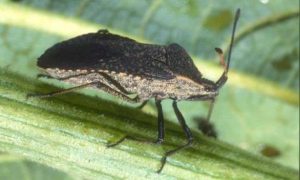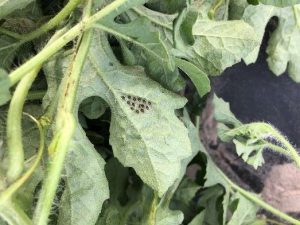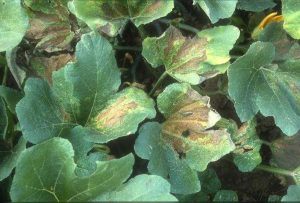Spring has sprung and that means watermelon season in Suwannee County is here! Watermelons are quite a labor-intensive crop and controlling weeds, pests, and diseases throughout the entire season is not an easy task especially due to Florida’s hot, humid climate. One pest that has shown an increased presence in watermelon fields the past few years is the squash bug. Read on to find out more about squash bugs, their impact on watermelons, and how to control them.
What is a squash bug?

A squash bug is commonly found on crops in the Cucurbit family, such as squash, zucchini, pumpkins, cucumbers, cantaloupe, and watermelon. Squash bugs will overwinter in dead debris in the field or in wooded areas near the field till spring. Once the weather gets warmer, squash bugs will migrate towards new vegetation to feed on and begin reproduction. Squash bugs have sharp ‘piercing sucking’ mouthparts, that pierce foliage and suck out the sap.

Identification:
The squash bug is a fairly large pest that has a brownish gray body and flat back. The edges and underside of the abdomen have orange stripes. These pests can fly, but mostly walk around on plants and are often found on the underside of leaves. Squash bug eggs are bronze or dark brown in color. They will lay their eggs in clusters on the underside of leaves. If you notice grouping of eggs on the underside of leaves, it could potentially indicate there are squash bugs present.
Crop Damage:

The foliage is where most of the feeding takes place, but the fruit can also be fed upon. Squash bugs pierce the outer layer of plant foliage, suck sap out, and then inject a highly toxic saliva back into the plant, which causes the foliage to wilt, become blackened, and then die. This is due to the toxin preventing nutrient flow to the leaves. Damage can be seen on an entire plant or on only certain sections of a plant. The amount of damage on a plant is proportional to the density of squash bugs in a field. In addition, squash bugs can act as a vector for different pathogens, such as the cucurbit yellow vine disease, where the squash bug can transmit the pathogen to the plant.
Cultural Controls:
- Practice crop rotations
- Plant trap crops of squash around crop perimeters
- Clean equipment of debris
- Remove crop debris from the field in a timely manner once the season is over
Chemical Controls:
Squash bugs can be controlled with proper chemicals applications. To be effective, the chemical needs good contact coverage on the squash bug. Many of these chemicals can be harmful to beneficial insects and pollinators, so care must be taken to avoid this. If chemical is applied when flowers are present, it is recommended to apply late in the day when pollinator activity is minimal. For proper management practices of squash bugs, refer to the Vegetable Production Handbook of Florida for application information on products labeled for use by clicking here.
Remember to read and follow all label instructions.
UF/IFAS Extension in Suwannee County is an Equal Opportunity Institution.
 0
0
